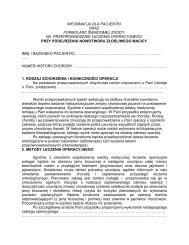pobierz prezentację jako plik PDF
pobierz prezentację jako plik PDF
pobierz prezentację jako plik PDF
You also want an ePaper? Increase the reach of your titles
YUMPU automatically turns print PDFs into web optimized ePapers that Google loves.
Executive SummaryLake Restoration TechniquesThe restoration of eutrophic or hypereutrophic lakes requires the reduction of bothexternal and internal phosphorus loads, as well as the implementation of othermanagement techniques. Therefore, in order to develop the Lake Hancock restorationplan it is important to evaluate available restoration technologies that reduce externaland internal loads, as well as other management techniques. Sediment inactivationtechniques (dredging, drawdown and mechanical excavation, chemical inactivation,and capping) and recirculating wetlands can remove internal loads. Treatmentwetlands and settling ponds can remove external tributary loads. Other in-lakerestoration techniques include increasing the lake water level, biological control, andlittoral zone habitat restoration. Treatment wetlands, settling ponds and filtration canbe used to treat the discharge from the lake.In order to restore this over-enriched, shallow and turbid lake and to restore a balanceto the aquatic flora and fauna, it is necessary to improve the quality of water withinthe lake. Phosphorus loadings must be reduced from the sediments in the lake as wellas from the tributaries. Over half of the annual phosphorus loading comes from thesediments and therefore, techniques that control the phosphorus input from thesediments are critical to restoration of Lake Hancock. A brief description of therestoration techniques follows:„ Sediment Removal by Hydraulic Dredging – A barge-mounted pumping systemis used to remove submerged sediment from the lake. This technique can provideefficient removal of sediments from the lake.„ Lake Drawdown and Mechanical Excavation – Lake water is allowed to drainthrough the existing P-11 structure at South Saddle Creek, and when sufficientlydry, earth-moving equipment can be used to remove sediments from the lakeshoreline.„ Chemical Inactivation of Sediment with Alum – Alum is used to immobilizephosphorous within the sediment. The phosphorus and alum bind and settle,becoming unavailable for release back into the water column.„ Capping of the Sediments with an inert substance – Clean sand, gravel,geotextiles, or synthetic liner may be used to cover the submerged sediment. Thisactivity would also help bind nutrients within the sediment.„ Recirculating Treatment Wetland – This technique removes particulatephosphorous by removing algae and resuspended sediments. This isaccomplished by pumping lake water into a filtration wetland, cleaning the waterthrough nutrient uptake and settling.„ Wetland Treatment of Inflows – This technique involves the construction ofwetlands to treat tributaries entering Lake Hancock. The wetlands capture andtransform nutrients from the tributaries before they enter the lake.ES-2O:\dang\Lake Hancock\Final\ExecSummary.doc



